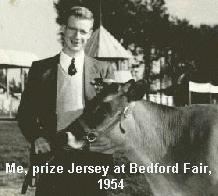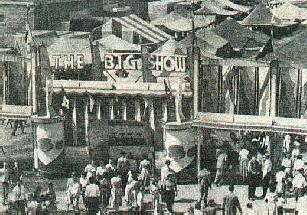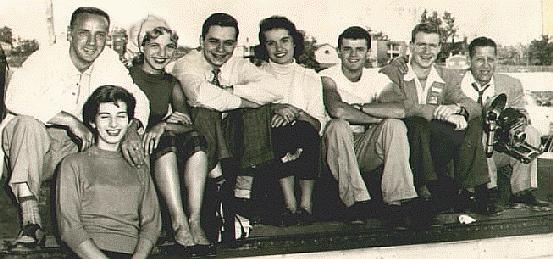Cows, horses and sulkies at the county fairs

Summer reporting from 11 communities
Candy floss and cattle, popcorn and poultry, harness racing and midway rides; that's the recipe for county fairs everywhere.
In Quebec's Eastern Townships during the early 50s, there was one in each of the 11 counties, starting at the beginning of August, and running until mid-September. They were all major community events.

I got my first assignment to cover one of these fairs in July, 1953 -- my first year as a reporter. It was the Missisqoui County fair in Bedford, the oldest in the Townships, going back to 1829. Then I was sent to a second one, the Megantic County Fair in Inverness.
The following summer, I was at it again, but this time, I did all 11, including the big Sherbrooke Fair, "Canada's Great Eastern Exhibition." They became my "beat" and I reported the county fairs every summer I was at the Record until the end of 1957. We called them "the country fairs," and for a city-bred teenager, the sights and smells and sounds were instantly attractive.
I learned to know the difference between Jersey and Ayrshire cattle, and all the other breeds. The same with horses and poultry and sheep. I interviewed farmers, grandstand performers, sulky drivers, fair presidents, quilters, 4-H clubbers and many of the other people who come together to make a county fair. I developed the skills to win big stuffed dolls and animals regularly at some midway booths, and in the process, discovered the ones where it was impossible to win anything anytime.


SUMMER OF 1957: Right, entrance to the Sherbrooke Exhibition; left, fairgrounds at Waterloo
While the Missisquoi County fair was the oldest in the Townships, some of the others were also well over a hundred years old in the 1950s, and the rest went back to the late 19th Century. The Stanstead County fair in Ayer's Cliff was first held in 1845. The Sherbrooke Exhibition was a comparative youngster, starting in 1885.
The fairs varied widely in size. One of the smallest was the Wolfe County fair held in the tiny community of Marbleton. It was a two-day affair, and was judged a success if a total of 1,500 people attended. Another very small one was in Danville. It was discontinued about 1956. The Shefford County Fair held over three days every summer in Waterloo, was for a long time one of the most successful of the bunch. But it was discontinued in 1958 after attracting 14,500 people the year before.
The Sherbrooke Exhibition always attracted large crowds throughout the 1950's. It was a six-day affair, and single-day crowds of 20,000 and more were not unusual.
While rainy weather was one of the hazards of the fair season, not even the tail-end of Hurricane Carol on August 31, 1954, could shut down the Sherbrooke fair. Over 1,000 hardy souls attended the fair on the day the storm hit, and when the rain stopped the next day, attendance was over 11,000.

PRESS MEMBERS AND FAIR PERFORMERS get together for a group picture at the Sherbrooke Exhibition in 1954. Left, seated, is Ivan Boisvert, photographer for Sherbrooke's French-language daily, La Tribune.Third from left is Warren Spafford, Record reporter. On extreme right is Royal Roy, photographer for Gerry Lemay Studio, the Record's photo service. Next to him is Hugh Doherty, Record reporter. The rest of the people are performers in the fair's grandstand show. Their names were not recorded.
The Record was a prominent participant at all the fairs, providing prizes in many categories. At the 1954 Marbleton Fair, for example, the Sherbrooke Daily Record special prize for the best grade steer was won by ROBERT DUMAS. At the 1955 Richmond Fair, the Record prize for the highest aggregate in the preserving and pickling department was won by MRS. L. L. HEALY. In the same year, at the Bedford Fair, MRS. B. L. GARDNER of Bedford won the Record prize for the best tray of six miniature cooked articles.
There was also a Record booth at each fair, manned by one of the paper's country correspondents, MRS. PEARL WILLIAMS of Foster. She travelled from fair to fair each summer with her portable typewriter. Mrs. Williams sold subscriptions and ads and also gathered all the judging results from the judges' sheets, typing them out and sending them into the Record for publication.
Each fair's results filled many columns of type, and so lists appeared in the paper almost daily for several months after the fair season had closed. If any prize winner was left out, or a name misspelled, the paper heard about it.

Driving through the night on one kidney
Reporters at the Record couldn't afford cars, and there were no staff vehicles, so all trips were made in a photographer's car. Gerry Lemay Studio provided the paper's photo service, and the studio's main photographer through the 50s was ROYAL ROY. He was a very short, bilingual francophone who had fought overseas during the Second World War, and was always joking it cost him a kidney.He was reliable, gregarious and laughed a lot. Because he took people's pictures, everyone wanted to meet him, so everywhere we went, he got to know a lot of people quickly. A green reporter couldn't have asked for a better partner on the country fair circuit.
There was a lot of travelling, and no superhighways in those days. Most fairs were three-day affairs, and we tried to cover the opening day and the closing day of most of them. That usually meant a Friday and a Sunday. We would be on the road early in the morning, do our coverage of the fair, then drive back to Sherbrooke in the evening, sometimes quite late. The Record couldn't afford overnight stays in hotels.
Often, stories had to be written and pictures printed before we could get some sleep so they would be ready for the next morning's deadline. To save time, I learned to write my stories out longhand in my notebook as Royal drove through the night. No laptops in those days. Royal would let me keep the dome light on to see what I was doing. Back at the office, I would then type out what I had written and it was ready for editing.
Royal moved to Sherbrooke's French-language daily, La Tribune sometime in the the late 1950's and was still there when I left Sherbrooke in 1968.
Home page | History of The Record | Those Were The Days
Glenn Gould Comes to Town | The Editors | Learning on the Job
A First in Canada | The Strike of '62 | 60th Anniversary in 1957
Trudeaumania Hits the City | Montreal's Expo 67 | Nightstaff: a poem
Memorable Headlines
Comments? Click here to E-mail author Hugh Doherty
Page created Spring 1999. Last updated Apr. 8, 2006